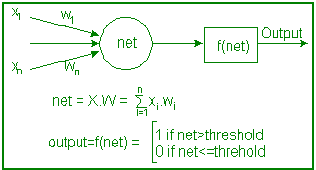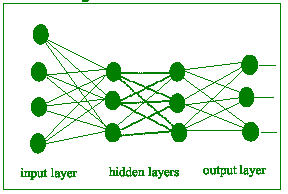|
(a) Draw a labeled diagram of a binary
output artificial neuron activated by a step threshold function. Show
clearly the calculations involved. [3]
Solution diagram:

1 mark for diagram, 1 mark for each formula
(b) Given the following information:
input vector [x1,x2]
weight vector [w1, w2]
threshold, t
target output, o
|
[1, 0]
[0.25, 0.25]
0.30
1 |
(i) Calculate the output of the neuron,
showing clearly the working. [2]
(ii) Using the values calculated above, explain the learning process.
[3]
(iii) Briefly describe the type of learning involved for the above
situation. [3]
(i) net = 1x0.25 + 0x0.25 = 0.25 [1]
output = 0, since 0.25<0.30 [1]
(ii) The actual output is 0 and the target output is 1. [1] There
is a
need to increase the weight for the active inputs, for this case,
there is only one, which is x1. [1] Through a learning rule, the
weight w1 will be increased gradually until it exceeds the
threshold, after which the neuron would fire. [1]
(iii) The type of learning in this situation is known as supervised
learning. [1] A training set made up of training pairs, which in turn
comprises the input and target output vectors, is used to train the
neuron.[1] If the actual output is different from the target output,
a learning algorithm is used to adjust the weights so that the
target output is eventually obtained.[1]
(c) With the aid of a labeled diagram,
describe what is meant by a multilayer
artificial neural network. State one advantage of such a network.
[4]
Solution diagram

Multi-layer artificial neural networks are
formed by cascading a group of single layers. [1] The output of one
layer provides the input to the
subsequent layer [1]. Advantages are: mimicing the structure of the
brain; more advanced capabilities than a single-layer network. [1]
for one advantage.
|

